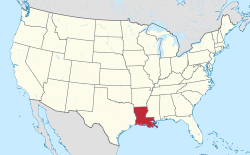
Washington Parish is a parish located in the interior southeast corner of the U.S. state of Louisiana, one of the Florida Parishes. As of the 2020 census, the population was 45,463. Its parish seat is Franklinton. Its largest city is Bogalusa. The parish was founded in 1819.

Union Parish is a parish located in the north central section of the U.S. state of Louisiana. As of the 2020 census, the population was 21,107. The parish seat is Farmerville. The parish was created on March 13, 1839, from a section of Ouachita Parish. Its boundaries have changed four times since then.

Caryville is a town in Washington County, Florida, United States located along the Choctawhatchee River. The Caryville is part of the Florida Panhandle in North Florida. The population was 301 at the 2020 census.

Lake Arthur is a town in Jefferson Davis Parish, Louisiana, United States. The population was 2,738 at the 2010 census, down from 3,007 at the 2000 census. It is part of the Jennings Micropolitan Statistical Area. The current mayor is Sampson “poncho” Lejeune.

Dubach is a town in Lincoln Parish, Louisiana, United States. The population was 908 in 2020. Dubach is part of the Ruston micropolitan statistical area.

Ponchatoula is the second-largest city in Tangipahoa Parish, Louisiana. The population was 6,559 at the 2010 census and 7,545 at the time of the 2020 population estimates program.

Bogalusa is a city in Washington Parish, Louisiana, United States. The population was 12,232 at the 2010 census. In the 2020 census the city reported a population of 10,659. It is the principal city of the Bogalusa Micropolitan Statistical Area, which includes all of Washington Parish and is also part of the larger New Orleans–Metairie–Hammond combined statistical area.

Kiln is an unincorporated community and census-designated place (CDP) in Hancock County, Mississippi, United States. The town is located about 50 miles (80 km) northeast of New Orleans, Louisiana. It is part of the Gulfport-Biloxi Metropolitan Statistical Area. The population was 2,238 at the 2010 census.

DeRidder is a city in, and the parish seat of, Beauregard Parish, Louisiana, United States. A small portion of the city extends into Vernon Parish. As of the 2010 census DeRidder had a population of 10,578. It is the smaller principal city of the DeRidder-Fort Johnson South CSA, a Combined Statistical Area that includes the Fort Johnson South and DeRidder micropolitan areas, which had a combined population of 87,988 at the 2010 census.
Moyers is an unincorporated community located in Pushmataha County, Oklahoma, United States.
The Great Southern Lumber Company was chartered in 1902 to harvest and market the virgin longleaf pine forests in southeastern Louisiana and southwestern Mississippi. Bogalusa, Louisiana was developed from the ground up as a company town and was the location for Great Southern Lumber Company's sawmill, which began operation in 1908. Other company interests included a railroad and paper mill. The company ceased operation in 1938, when the supply of virgin pines was depleted. Bogalusa became the site of a paper mill and chemical operations, followed by other industry.
Roy is an unincorporated community located approximately two miles south of Castor in Bienville Parish in northern Louisiana, United States. To the south of Roy is Ashland in Natchitoches Parish. Named for Roy Otis Martin, Sr. (1890-1973), the community was the location of a closed sawmill owned and operated by the Martin Timber Company based in Alexandria, Louisiana, and operated by Martin's son, Roy O. Martin, Jr., and then his grandson, Roy O. Martin, III until sold to Hunt Plywood in 1992.
The Williamsport and North Branch Railroad was a short line that operated in north-central Pennsylvania between 1872 and 1937. After a long struggle to finance its construction, it was completed in 1893. It derived most of its freight revenue from logging and to a certain extent from anthracite coal traffic. It also carried many passengers to mountain resorts in Sullivan County, Pennsylvania. With the decline of the logging industry and increased accessibility of the region by automobile in the 1910s and 1920s, the railroad's business rapidly declined. The economic blow of the Great Depression proved insurmountable, and it was abandoned as unprofitable in 1937.
Dry Creek is a rural unincorporated community in the east-central portion of Beauregard Parish, Louisiana, United States. It lies 20 miles (32 km) southeast of DeRidder on the corner of Louisiana highways 113 and 394. Dry Creek is 104 feet (32 m) above sea level.

Hannibal is an unincorporated community located in Taylor County, Wisconsin, United States. Hannibal is located on Wisconsin Highway 73 and County Highway M north of Gilman, in the town of Cleveland. Today Hannibal is quiet, but once it was a bustling little economic hub at the junction of two logging railroads.

Whittlesey is a census-designated place in the town of Chelsea, Taylor County, Wisconsin, United States. Its population was 105 as of the 2010 census.
Brittany is an unincorporated community in Ascension Parish, Louisiana, in the United States.
The Louisiana and Texas Lumber War of 1911–1912 was a series of worker strikes that fought for better conditions in sawmills in the Piney Woods of west Louisiana and East Texas. These sawmills underwent attempts to unionize that were opposed by lumber companies and owners. The union workers were known as the Brotherhood of Timber Workers (BTW), a branch of the Lumber Workers Industrial Union (LWIU), which was affiliated with the Industrial Workers of the World (IWW). The Brotherhood tried to recruit mill workers by giving speeches and conducting meetings at various mills. Although they had limited success in Louisiana, the LWIU became very successful from 1917 to 1924.
Oakland, Union Parish, Louisiana is a former community in northern Union Parish, Louisiana, United States. About one mile south of the Arkansas state line, it is 18 miles (29 km) north of Farmerville and 10 miles (16 km) northwest of Marion. It was also known as Union Cross Roads and Springhill or Spring Hill.














